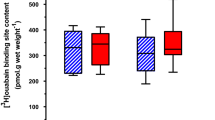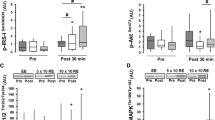Abstract
Clenbuterol, a β2-adrenergic-receptor agonist, is known to provoke muscle hypertrophy and a slow-to-fast phenotype change. A more glycolytic phenotype should be paralleled by changes in muscle glycolytic metabolism. Two groups (n=16 for each) of 3-month-old male Wistar rats (UCL: untrained clenbuterol, and ECL: exercised clenbuterol) received a chronic administration of clenbuterol (2 mg/kg body weight/day). Two other groups of animals (U: untrained and E: exercised), were given a 0.9% NaCl solution instead of clenbuterol. E and ECL animals followed an 8-week progressive isometric force strength-training program. Both clenbuterol administration and training resulted in an increase in extensor digitorum longus (EDL) mass despite the fact that this muscle was indirectly mobilised during isometric force strength training. Clenbuterol and training induced a consistent slow-to-fast phenotype change without drastically increasing specific activities of glycolytic enzymes. Except for GAPDH and hexokinase, modifications in glycolytic-enzyme-specific activities were not explained by transcriptional changes. Lactate dehydrogenase activity was not affected by clenbuterol but was strongly augmented by training. In EDL of ECL rats, both treatments presented an opposite effect compensating each other. GLUT1 mRNA expression was augmented in EDL of UCL and ECL animals, whereas monocarboxylate transporter 1 mRNA amounts were decreased in EDL of UCL rats. Citrate synthase activity was reduced by clenbuterol treatment but remained unchanged in EDL of E animals. Creatine kinase activity was enhanced only by clenbuterol alone. These data show that clenbuterol-induced muscle hypertrophy and slow-to-fast phenotype changes are not associated with a glycolytic-enzyme-activity increase. They also suggest that in EDL isometric force strength training can reverse clenbuterol-induced molecular adaptations.







Similar content being viewed by others
References
Anderson G, Wilkins E (1997) A trial of clenbuterol in bronchial asthma. Thorax 32:717–719
Awede BL, Thissen JP, Lebacq J (2002) Role of IGF-I and IGFBPs in the changes of mass and phenotype induced in rat soleus muscle by clenbuterol. Am J Physiol Endocrinol Metab 282:E31–E37
Benovic JL (2002) Novel beta2-adrenergic receptor signaling pathways. J Allergy Clin Immunol 110:S229–S235
Bertin E, Ruiz JC, Mourot J, Peiniau P, Portha B (1998) Evaluation of dual-energy X-ray absorptiometry for body-composition assessment in rats. J Nutr 128:1550–1554
Bonen A (2001) The expression of lactate transporters (MCT1 and MCT4) in heart and muscle. Eur J Appl Physiol 86:6–11
Cavalié H, Horcajada-Molteni MN, Lebecque P, Avicco MJ, Coxam V, Lac G, Barlet JP (2003) Progressive isometric force training and bone mass in rats. J Musculoskelet Neuronal Interact 3:47–52
Cavalié H, Lac G, Lebecque P, Chanteranne B, Davicco MJ, Barlet JP (2002) Influence of clenbuterol on bone metabolism in exercised or sedentary rats. J Appl Phys 93:2034–2037
Cavalié H, Mounier R, Clottes E, Bricout V, Lac G (2004) Clenbuterol treatment differently affects muscle in exercised or sedentary rats. J Exerc Physiol 7:111–120
Clarkson PM, Thompson HS (1997) Drugs and sport. Research findings and limitations. Sports Med 24:366–384
Delbeke FT, Desmet N, Debackere M (1995) The abuse of doping agents in competing body builders in Flanders (1988–1993). Int J Sports Med 16:66–70
Herrera NM Jr, Zimmerman AN, Dykstra DD, Thompson LV (2001) Clenbuterol in the prevention of muscle atrophy: a study of hindlimb-unweighted rats. Arch Phys Med Rehabil 82:930–934
Joseph J, Cruz-Sanchez FF, Carreras J (1996) Enolase activity and isoenzyme distribution in human brain regions and tumors. J Neurochem 66:2484–2490
Juel C, Halestrap AP (1999) Lactate transport in skeletal muscle- role and regulation of the monocarboxylate transporter. J Physiol 517:633–642
Kandus J, Salat D (1987) Treatment of bronchial obstruction in asthma. Bull Eur Physiopathol Respir 23(Suppl 10):S103–S105
Kitaura T, Tsunekawa N, Hatta H (2001) Decreased monocarboxylate transporter 1 in rat soleus and EDL muscles exposed to clenbuterol. J Appl Phys 91:85–90
Lac G, Cavalié H (1999) A rat model of progressive isometric strength training. Arch Physiol Biochem 107:144–151
Lynch GS, Hayes A, Campbell SP, Williams DA (1996) Effects of beta 2-agonist administration and exercise on contractile activation of skeletal muscle fibers. J Appl Phys 81:1610–1618
Maltin CA, Delday MI, Hay SM, Smith FG, Lobley GE, Reeds PJ (1987) The effect of the anabolic agent, clenbuterol, on overloaded rat skeletal muscle. Biosci Rep 7:143–149
Megeney LA, Neufer PD, Dohm GL, Tan MH, Blewett CA, Elder GC, Bonen A (1993) Effects of muscle activity and fiber composition on glucose transport and GLUT-4. Am J Physiol 264:E583–E593
Mitchell GA, Dunnavan G (1998) Illegal use of beta-adrenergic agonists in the United States. Anim Sci 76:208–211
Moore NG, Pegg GG, Sillence MN (1994) Anabolic effects of the beta 2-adrenoceptor agonist salmeterol are dependent on route of administration. Am J Physiol 267:E475–E478
Mueckler M (1994) Facilitative glucose transporters. Eur J Biochem 219:713–725
Navegantes LC, Machado CR, Resano NM, Migliorini RH, Kettelhut IC (2003) Beta2-agonists and cAMP inhibit protein degradation in isolated chick (Gallus domesticus) skeletal muscle. Br Poult Sci 44:149–154
Navegantes LC, Resano NM, Migliorini RH, Kettelhut IC (2001) Catecholamines inhibit Ca(2+)-dependent proteolysis in rat skeletal muscle through beta(2)-adrenoceptors and cAMP. Am J Physiol Endocrinol Metab 281:E449–E454
Nials AT, Coleman RA, Johnson M, Magnussen H, Rabe KF, Vardey CJ (1993) Effects of beta-adrenoceptor agonists in human bronchial smooth muscle. Br J Pharmacol 110:1112–1116
Perry H (1993) Clenbuterol: a medal in tablet form? Br J Sports Med 27:141
Philp NJ, Ochrietor JD, Rudoy C, Muramatsu T, Linser PJ (2003) Loss of MCT1, MCT3, and MCT4 expression in the retinal pigment epithelium and neural retina of the 5A11/basigin-null mouse. Invest Ophthalmol Vis Sci 44:1305–1311
Prather ID, Brown DE, North P, Wilson JR (1995) Clenbuterol: a substitute for anabolic steroids? Med Sci Sports Exerc 27:1118–1121
Rajab P, Fox J, Riaz S, Tomlinson D, Ball D, Greenhaff PL (2000) Skeletal muscle myosin heavy chain isoforms and energy metabolism after clenbuterol treatment in the rat. Am J Physiol Regul Integr Comp Physiol 279:R1076–R1081
Reeds PJ, Hay SM, Dorwood PM, Palmer RM (1986) Stimulation of muscle growth by clenbuterol: lack of effect on muscle protein biosynthesis. Br J Nutr 56:249–258
Rossignol F, Solares M, Balanza E, Coudert J, Clottes E (2003) Expression of lactate dehydrogenase A and B genes in different tissues of rats adapted to chronic hypobaric hypoxia. J Cell Biochem 89:67–79
Rossignol F, Vaché C, Clottes E (2002) Natural antisense transcripts of hypoxia-inducible factor 1alpha are detected in different normal and tumour human tissues. Gene 299:135–140
Rothwell N, Stock MJ (1985) Modification of body composition by clenbuterol in normal and dystrophic (mdx) mice. Biosci Rep 5:755–760
Spann C, Winter ME (1995) Effect of clenbuterol on athletic performance. Ann Pharmacother 29:75–77
Srere PA (1974) Controls of citrate synthase activity. Life Sci 15:1695–1710
Stuart CA, Wen G, Gustafson WC, Thompson EA (2000) Comparison of GLUT1, GLUT3, and GLUT4 mRNA and the subcellular distribution of their proteins in normal human muscle. Metabolism 49:1604–1609
Talmadge RJ, Roy RR (1993) Electrophoretic separation of rat skeletal muscle myosin heavy-chain isoforms. J Appl Physiol 75:2337–2340
Tsao TS, Li J, Chang KS, Stenbit AE, Galuska D, Anderson JE, Zierath JR, McCarter RJ, Charron MJ (2001) Metabolic adaptations in skeletal muscle overexpressing GLUT4: effects on muscle and physical activity. FASEB J 15:958–969
Waterfield CJ, Jairath M, Asker DS, Timbrell JA (1995) The biochemical effects of clenbuterol: with particular reference to taurine and muscle damage. Eur J Pharmacol 293:141–149
Wilson MC, Meredith D, Halestrap AP (2002) Fluorescence resonance energy transfer studies on the interaction between the lactate transporter MCT1 and CD147 provide information on the topology and stoichiometry of the complex in situ. J Biol Chem 277:3666–3672
Xiao RP, Cheng H, Zhou YY, Kuschel M, Lakatta EG (1999) Recent advances in cardiac beta(2)-adrenergic signal transduction. Circ Res 85:1092–1100
Author information
Authors and Affiliations
Corresponding author
Rights and permissions
About this article
Cite this article
Mounier, R., Cavalié, H., Lac, G. et al. Molecular impact of clenbuterol and isometric strength training on rat EDL muscles. Pflugers Arch - Eur J Physiol 453, 497–507 (2007). https://doi.org/10.1007/s00424-006-0122-1
Received:
Revised:
Accepted:
Published:
Issue Date:
DOI: https://doi.org/10.1007/s00424-006-0122-1




